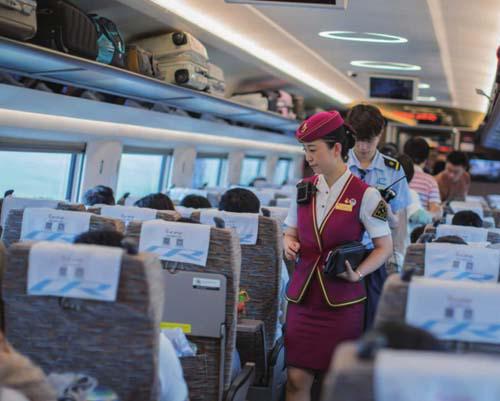A Story on Track
2018-08-24ByYuanYuan
By Yuan Yuan
At the end of 2017, the length of Chinas railway network was 127,000 km. Of this, there were 25,000 km of high-speed lines with a designed top speed of 350 km per hour, accounting for 66.3 percent of the global total. The length of high-speed railways is expected to reach 30,000 km by 2020, covering over 80 percent of cities with a population of more than 1 million.
Zhao Xiaoqin, born in 1984, has worked on eight different types of trains in her 15-year career and has witnessed the great changes on the tracks.
From fast to faster
Zhao started working on the trains in 2003 with the encouragement of her older sister, who was also a railway worker. She first worked aboard a T97, a passenger train between Beijing and Kowloon in Hong Kong. At the time, it was a fairly advanced train, equipped with air conditioning and comfortable seats. T stands for Tekuai, or superfast, and the speed was a little over 110 km per hour.
“Each of us on the service crew was in charge of one carriage, which included offering services and keeping everything clean,” Zhao said. “During holidays, the train was always fully packed and our mission was simply to get the passengers safely to their destinations.”
One of the duties of the service crew was to push a trolley piled with beverages and snacks through the aisles—which were always squeezed with passengers—making it a very diffi cult task. On trains with no automatic water boilers, the service crew had to carry a kettle to offer hot water to passengers.
Even so, it was a huge upgrade from the socalled “green” trains, which were painted green, could run at a speed as slow as 30 km per hour and dominated the railways nationwide before the 1990s. They had no air conditioning and were extremely hot in summer since they were always packed with passengers due to their low prices. The smell on the train was usually a mixture of body odor, instant noodles and smoke, since there were no designated smoking areas.
In the 1990s, China started to introduce more air-conditioned trains with faster speeds and more comfortable seats, and the green trains were mostly phased out, although they can still be seen in some parts of the country.
In 2007, the train that Zhao worked was upgraded to a bullet train, known as Hexie, or harmony. It ran at a much faster speed, about 200 km per hour, was equipped with advanced facilities and was much less crowded.
“Every passenger was excited to be on the new train and they had many questions about it,” Zhao said. “We needed to be well-prepared to answer questions and provide better service.”
Smart and enjoyable
In the initial stage, the high-speed trains in China were based on Japanese, German and French technologies. In June 2017, China launched its f irst high-speed trains with totally self-developed technologies. Fuxing, or rejuvenation, as the new train is called, is expected to replace Hexie in the future.
Zhao now works as a train conductor on a Fuxing train between Beijing and Shanghai. “The high technology greatly lifts the service,” Zhao said. Since late 2011, passengers can purchase train tickets online, and beginning in October 2017, they can also choose seats online.
In the past, the meal choices were quite limited on the train. Passengers who didnt want to buy meals on the train would carry instant noodles onboard. But now passengers can order food online from restaurants in and near railway stations and the crew helps to deliver these meals to their seats.
In addition, as many high-speed trains have onboard Wi-Fi, passengers can surf online with their smartphones and make the trip more comfortable.
In her new position, Zhao needs to check every detail of the train with the technicians before every trip to ensure safety. After check- ing every part, she scans a QR code to record her fi ndings. “In the past, all the working records were written on a thick notebook,” Zhao said.“Now we have an app that replaces it.”
Zhao has kept all her work permits from the past 15 years and the keys she used on different trains. “The keys now are smaller but have more functions,” Zhao said. “Highspeed trains have developed at a striking speed and have become the fi rst choice for many passengers.”
